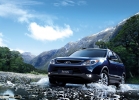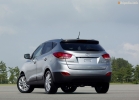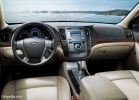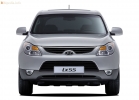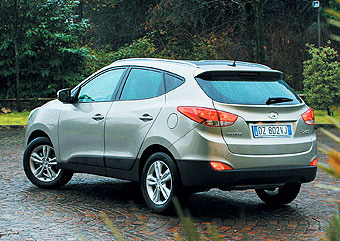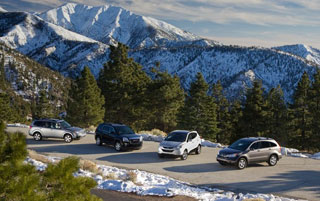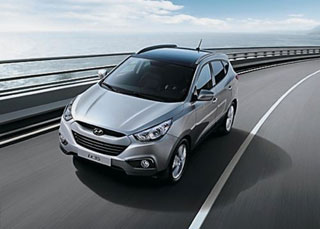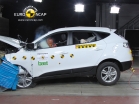Hyundai IX35 (TUCSON) test drive since 2009 SUV
Arguments for"
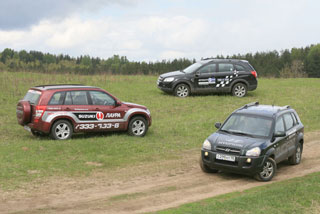 The appearance of the Ford Kuga new player in the crossover market makes the rest if you do not squeeze, then at least strain. Moreover, when it comes to a new product from a manufacturer who proved his ability to lead in a variety of segments. However, the leaders of sales of recent years will probably find arguments to protect their positions.
The appearance of the Ford Kuga new player in the crossover market makes the rest if you do not squeeze, then at least strain. Moreover, when it comes to a new product from a manufacturer who proved his ability to lead in a variety of segments. However, the leaders of sales of recent years will probably find arguments to protect their positions. We decided to evaluate three cars at once, comparable to the new Ford. As you know, the basic price of Kuga is 880,000 rubles. The cars we tested in minimal versions are much cheaper, and in the maximum more expensive.
 So: Grand Vitara recognized Suzuki bestseller, the most affordable Japanese crossover in the market.
So: Grand Vitara recognized Suzuki bestseller, the most affordable Japanese crossover in the market. Tucson is one of the cornerstones of Hyundai success in Russia, according to the results of sales over the past year, only RAV4 lost.
Captiva is practical Chevrolet, which provides, according to the new brand standards, new opportunities for the same money.
What arguments will they be able to present in their favor?
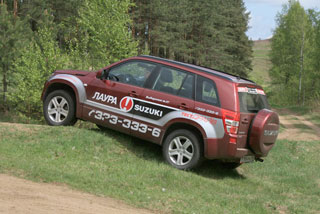 Suzuki Grand Vitara 2.0 4WD
Suzuki Grand Vitara 2.0 4WD Outside
Suzuki Grand Vitara SUV (and this is precisely SUV) with a concise and healthy conservative design and a stock on the back gate. His opponents cannot boast of this.
GV looks at the world with uncomplicated rectangular headlights (in which xenon can shine for a surcharge) and puts around the surrounding surfaces of the hood and doors to others. The relief of the sidewalls is disturbed only by the allocated arches with a contour, as if filled with a grinder.
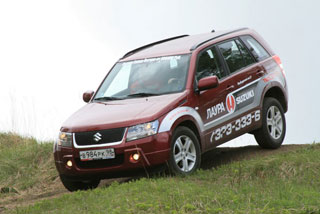 The large area of \u200b\u200bglazing provides an excellent overview of the cabin, and from the outside makes the car visually larger and solid. There can be 16- or 17-inch wheels in wheeled arches. Moreover, a five -door version with an automatic gearbox is equipped only with alloy wheels with a size of 17 inches.
The large area of \u200b\u200bglazing provides an excellent overview of the cabin, and from the outside makes the car visually larger and solid. There can be 16- or 17-inch wheels in wheeled arches. Moreover, a five -door version with an automatic gearbox is equipped only with alloy wheels with a size of 17 inches. Not in a Japanese modest car, maybe it doesn’t look so bright even against the background of today's rivals, but is the main thing the main thing on the off-road?
Inside
Spacious and straightforward. The design remained at the level of the previous generations of Toyota Rav4 and Honda CR-V, but despite this, sitting inside Grand Vitara is pleasant and convenient. And against the background of competitors of GV, the design of his interior does not seem so old -fashioned.
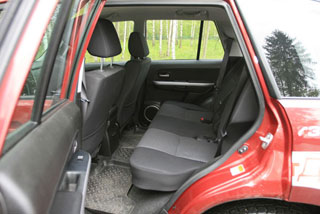 Ergonomics at a good level: the seat and the steering wheel move in a wide range, so it is convenient to get settled even the absence of longitudinal rudder adjustment does not interfere. The steering wheel itself is quite slippery, and the plastic of the salon is harsh (although it does not creak and okay).
Ergonomics at a good level: the seat and the steering wheel move in a wide range, so it is convenient to get settled even the absence of longitudinal rudder adjustment does not interfere. The steering wheel itself is quite slippery, and the plastic of the salon is harsh (although it does not creak and okay). The seats, on the contrary, are too soft, but, despite this, their side support is excellent. There are many places for passengers; And even a tall driver will sit down after himself without any problems. And in the trunk (with the seats raised), a little less than 1,000 liters of luggage will fit.
The devices are framed by spectacular circles-collar, but the dials themselves are nowhere easier. Nevertheless, they cannot occupy information content. It turned out: the easier the better ...
The assembly quality is very high: the panels fit tightly to each other and do not make extraneous sounds. Nevertheless, GV still misses aerodynamic noises and the roar of the motor, although we do not consider Suzuki to loud cars.
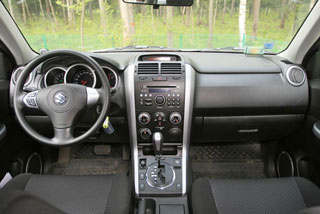 In move
In move Grand Vitara is unexpectedly greatly controlled: the steering is accurate and informative, and the car itself is dutifully and quickly follows the steering teams. But the driver’s setting unpleasantly affects the comfort of Suzuki literally conveys the quality of asphalt to the body. Accordingly, the worse the road, the stronger the vibration transmitted to the body. Here, the softness of the suspension Hyundai and Chevrolet seemed an enviable advantage.
But, despite the stiffness, GV is at least no worse than other test participants prepared for sorties outside the asphalt. Between his axes is a blocked center differential, and a lowering gear is provided in the handout. Even on urban tires, we did not experience problems with the movement of hills and ravines. And 200 mm of a road clearance is the ability to overcome quite large obstacles and not be afraid to hurt them.
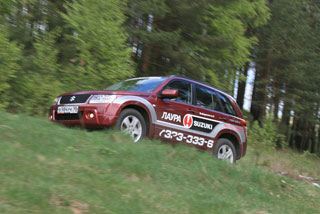 Technical characteristics of Suzuki Grand Vitara 5 DR. Automatic transmission:
Technical characteristics of Suzuki Grand Vitara 5 DR. Automatic transmission: Dimensions, mm (length x width x height) 4470x1810x1695
Road clearance, mm 200
Equipped mass, kg 1 595
Trunk volume, l 400
Engine volume and power, L (L.S./at rpm) 2.0 (144/6000)
Maximum torque, NM at rpm 183/4000
Acceleration to 100 km/h, p. 11.8
Maximum speed, km/h 170
Average fuel consumption (city/highway) l/100 km 12.1/7.9
Office conquerors can be upset: the current generation of Grand Vitara has lost the frame in its classical sense (it is now integrated into the body), but this has become more comfortable at high speeds and if it has lost its patency, it is a little.
Suzuki accelerates well, especially for a one and a half -ton SUV with a two -liter engine and an automatic machine. But with braking there are problems, if not with the effectiveness of slowdown, then with its sensation: the left pedal is minimally informative.
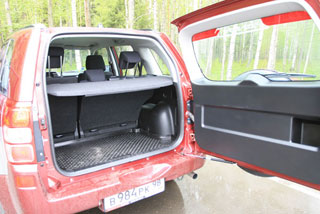 Total
Total The combination of price/quality, a high level of equipment, a traditionally appreciated Japanese assembly plus off -road abilities put Suzuki into a number of very interesting offers in the market. Unless, of course, you are ready to sacrifice part of the driving comfort for the sake of good controllability, which the SUVs are so rarely different
Prices
Suzuki Grand Vitara sets not so much but there is an option with a three -door body. It is the most affordable only with a 1.6 engine, and costs from 665,000 rubles. The car will have two airbags, ABS, hydraulic wrap, central lock, seats, climate control, electric windows, audio training, full -time immobilizer. The five -door version with the 2.0 and the manual transmission costs from 778,000 rubles, with the automatic transmission from 840,000 rubles. In the most expensive car for 933,660 rubles, side pillows, Cruise Contolu, CHEEIN, Leather Salon, Anti-Tax System, ESP, and Luke in the Roof will appear.
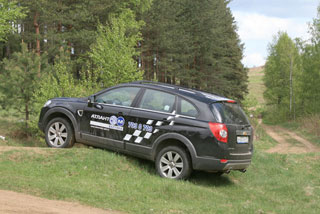 Chevrolet Captiva 3.2 4WD
Chevrolet Captiva 3.2 4WD Outside
Here is a big man! Despite the fact that the main consumer of Captiva was to be the European public, and the production of the machine smoothly migrated to Korea, Poland and Russia, several clearly American strokes in design can be traced for sure.
Here is the smooth arc of the roof and does not think to fall to the rear window, visually lifting the back, otherwise how to squeeze a third row of seats into the cabin?! Even the dashing lines of lateral glazing, forming an acute angle in the area of \u200b\u200bthe posterior window (as on a sports CR-V!) Do not contribute to the visual relief of the crossover.
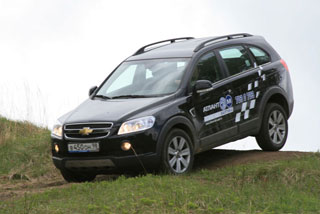 But the full size of the body entails bonuses like wide and high doorways, a spacious salon and a comfortable trunk, and external slowness can be compensated by additional liters of the working volume of the motor: on our Chevrolet test, the most powerful.
But the full size of the body entails bonuses like wide and high doorways, a spacious salon and a comfortable trunk, and external slowness can be compensated by additional liters of the working volume of the motor: on our Chevrolet test, the most powerful. Inside
Captiva salon is a collective image of the Chevroletov style of recent years. Many elements are borrowed not only from the budget upstart of the Epica business class, but even the modest baby Aveo! It is unlikely that this will add optimism to Captiva customers who have laid out more than a million for the car in the top version, but if you do not find fault much, the interior is quite convenient and practical.
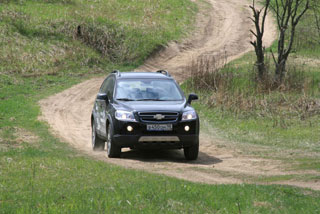 I liked the seats correct profile and tangible lateral support will not allow you to get tired even on a long trip. The front console impresses with its monumentality, but in the case it could be more convenient: the oblong window of the radio screen is hidden somewhere below, and it is inconvenient to read the information displayed by a pale green color.
I liked the seats correct profile and tangible lateral support will not allow you to get tired even on a long trip. The front console impresses with its monumentality, but in the case it could be more convenient: the oblong window of the radio screen is hidden somewhere below, and it is inconvenient to read the information displayed by a pale green color. But the testimony of the flight comprehensive compliance and the climatic installation in its appearance: at the top of the central beard.
The main advantage of the Chevrolet Captiva salon, I repeat, in its size: the front saddings even in the winter jackets do not touch each other's shoulders, the second row will take three without problems, and if you make up, you can plant two more children on the gallery.
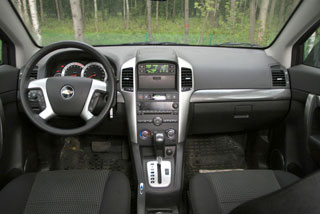 In move
In move Touch almost a ton of eight hundred equipped weight for 225 horses under the hood task of trifling. At least this hints at an evil, bass murmur, which is published by the exhaust system. But the hydrotransformer of the automatic box with a wall stands in the way of power stream and strangles the prominent greenhouse. In fact, this happens like this: you press on the gas, after which you wait a few seconds of adequate return.
Technical characteristics of the Chevrolet Captiva 3.2 automatic transmission:
Dimensions, mm (length x width x height) 4635x1850x1720
Road clearance, mm 200
Equipped mass, kg 1790
Trunk volume, l 965
Engine volume and power, L (L.S./at rpm) 3.2 (225/6600)
Acceleration to 100 km/h, p. 9.8
Maximum speed, km/h 205
Average fuel consumption (city/highway) l/100 km 13.5/11.5
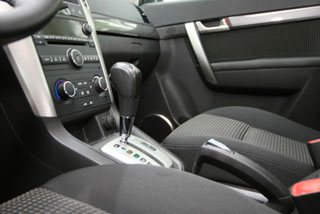 In fairness, we note that the whole problem is solved by a smooth press on the accelerator. Then acceleration occurs without delays and a twitching power rupture. The same applies to the brakes the sensitive mechanism requires gentle handling, otherwise the heavy frontiva front will be discovered by bow to each red traffic light.
In fairness, we note that the whole problem is solved by a smooth press on the accelerator. Then acceleration occurs without delays and a twitching power rupture. The same applies to the brakes the sensitive mechanism requires gentle handling, otherwise the heavy frontiva front will be discovered by bow to each red traffic light. On irregularities, the soft suspension Chevrolet behaves quite collected. Her moves are small, but there is no tendency to breakdown. On irregularities, it shocks you, but it can still be said that hilly ground routes for Captiva are the same native element as asphalt.
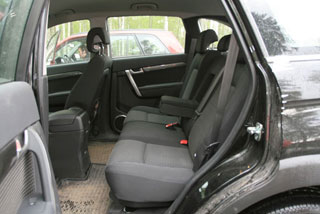 The car enters the turns with some lazy, forcing the steering wheel to work more actively and the high center of gravity makes itself felt.
The car enters the turns with some lazy, forcing the steering wheel to work more actively and the high center of gravity makes itself felt. Total
Chevrolet Captiva, having a price comparable to competitors, has three advantages of a powerful voluminous engine, a spacious interior and an additional series of seats. And if the cubic centimeters of the motor may not touch the consumer’s heart (especially in the light of the latest increase in gas prices), then the size and seats are always in price.
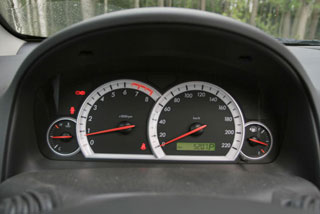 Prices
Prices The cheapest Chevrolet Captiva with a 2.4 engine and a manual box costs from 798,700 rubles. The car will have frontal and ceiling airbags for the driver and passenger, ESP, ABS, electric windows, air conditioning, central castle, and hydraulic power steering. Places in the car - five. The same version, but in seven -seater design, is drawn by 817,000 rubles. For a car with a 2.4 engine and an automatic box, you need to pay from 9,25,300 rubles, and for a powerful 3.2 liter version will be asked from 10,23200 rubles. The box is only a machine gun.
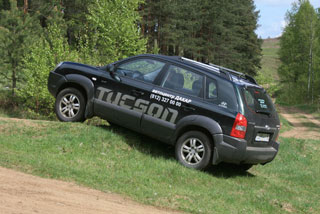 Hyundai Tucson 2.7 4WD
Hyundai Tucson 2.7 4WD Outside
The veteran (already!) Hyundai Tucson is ready to demonstrate that there is still gunpowder in powder. Despite the solid, by today's standards, three conveyor years, the design of the model is quite fresh and concise. No external charm, no delights are only correct lines and verified proportions. What is clearly like that: over the past year, the model has become an unconditional leader in the sales of foreign crossovers in Russia.
Being an almost accurate copy of Kia Sportage, Hyundai, nevertheless, is positioned as a more prestigious one. But the appearance does not mean this, can it cost to look into the salon?
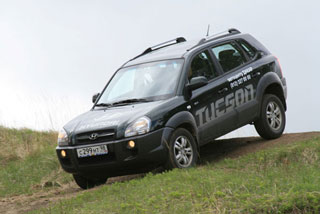 Inside
Inside Sitting in Tucson, after Togo, as I sat, say, in Captiva, it is dangerous: there is a risk of getting claustrophobia. Although the close interior can not be called a stock on the head and in width, but the excess of space is not felt.
Conducted a fairly dense assembly and good quality of plastic, although visually some elements dissonate with each other. For example, perfectly readable, although incredibly modest devices and a large, thin and terribly slippery steering wheel. Or the middle console, with a neatly located machine gun selector and a climate unit block and immediately a clumsy window for a foreign radio.
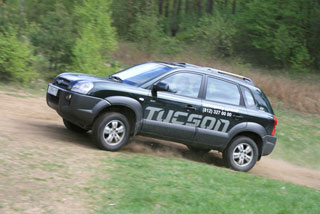 But you get used to such an interior quite quickly, since primitive keys and regulators, however, are conveniently located and do not require addiction. And the loud click of the steering wheel switches and the completely blind screen of the air conditioner will be attributed to the national color: these are the features of so many Korean cars.
But you get used to such an interior quite quickly, since primitive keys and regulators, however, are conveniently located and do not require addiction. And the loud click of the steering wheel switches and the completely blind screen of the air conditioner will be attributed to the national color: these are the features of so many Korean cars. In move
The copy that we got to the test, apparently, at one time mercilessly chased off -road, therefore, the incomplete 2,000 km of the run signed the sentence to the back stabilizer to the bushings: his knock now and then informed about the need to travel to the service. Hence the conclusion high landing plus all -wheel drive in total does not give full superiority outside the road!
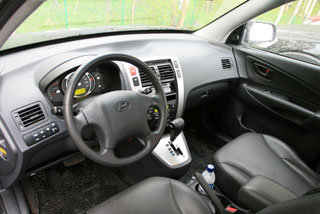 Hyundai Tucson suspension settings are rather urban: small pits swallow well, and in corners a high car does not allow strong rolls.
Hyundai Tucson suspension settings are rather urban: small pits swallow well, and in corners a high car does not allow strong rolls. Technical characteristics of the Hyundai Tucson 2.7 automatic transmission:
Dimensions, mm (length x width x height) 4320x1830x1730
Road clearance, mm 195
Equipped mass, kg 1568
Trunk volume, l 645
Engine volume and power, L (L.S./at rpm) 2.7 (175/6000)
Maximum torque, NM at rpm 241/4000
Acceleration to 100 km/h, p. 10.5
Maximum speed, km/h 180
Average fuel consumption (city/highway) l/100 km 13.2/8.2
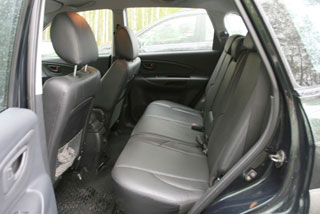 About the character of a 2.7-liter motor can be said that it is quite enough for confident maneuvers.
About the character of a 2.7-liter motor can be said that it is quite enough for confident maneuvers. In addition, the machine is quite quite cope with its work. If again, it is more smooth to work with gas. In addition, the automatic transmission has a manual mode, which, unfortunately, cannot be used as a semblance of a low row (when descent from a hill, for example): the machine slows down the machine reluctantly. But to amuse pride in traffic lights, please.
 Total
Total The popularity of the Hyundai Tucson is explained not only by a moderate price, but also a good balance of strength, there is a choice of power units, a service is well developed, the quality of Korean products does not fail. However, the factor of novelty also plays an important role, and with this, Tucson is not so perfect.
Prices
The most affordable version of the Hyundai Tucson is equipped with a 2.0 engine (142 hp), a mechanical box, and has a drive only to the front axle. There is such a car from 645 900 rubles. For this money, there will be from options: two front airbags, ABS+EBD, central locking, air conditioning, and wheels on cast discs. From 729 900 rubles. There is a car with automatic transmission, and from 725 900 rubles. with all -wheel drive (hand gearbox). With a motor 2.7, prices start from the mark of 860 900 rubles, and the diesel version (2.0, 112 hp) will be offered from 774 900 rubles. Everything is only with a machine gun.
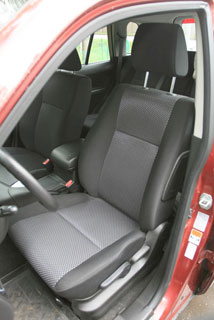
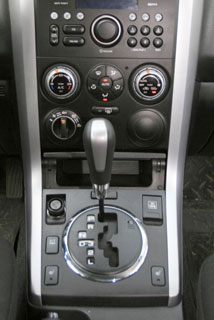
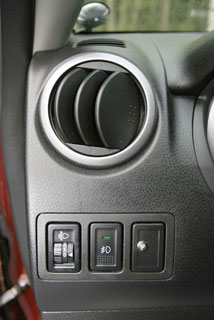
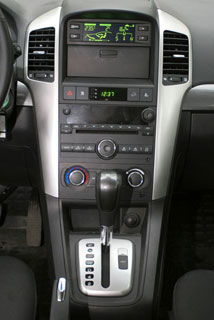
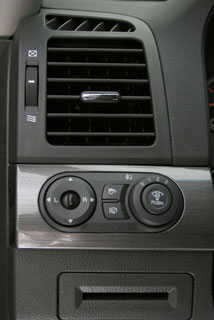
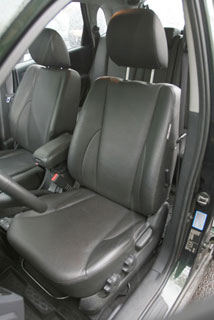
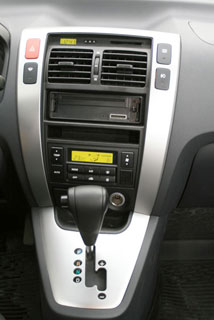
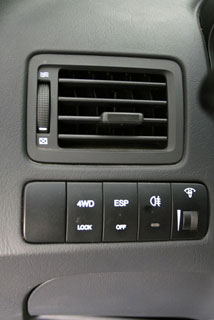
Text: Alexander Korobchenko Alexander Mikhailov,
Photo: Roman Ostanin
A source: Wheel magazine [June 2008]
Hyundai IX35 (TUCSON) Video Video since 2009
Hyundai IX35 (TUCSON) Krash Video since 2009
Hyundai IX35 (TUCSON) test drives since 2009
Hyundai IX35 (TUCSON) Krash Test since 2009
Krassh Test: Detailed Information90%
Driver and passengers
54%
Pedestrians
88%
Children-passengers
71%
Active security system

